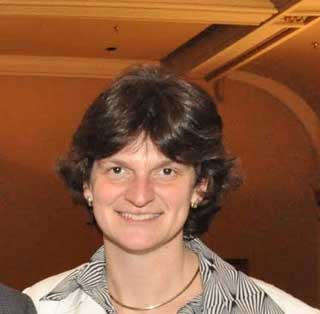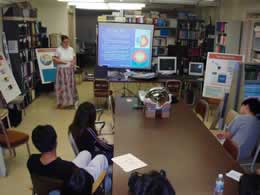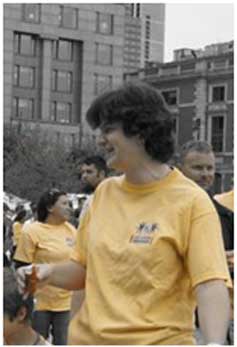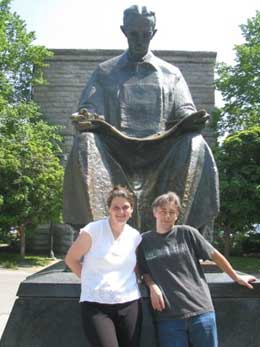Jelena Maricic

Jelena Maricic
Nursery rhymes, fairy tales, fables. These stories give meaning to the world, explaining extraordinary events and observations. They answer questions like: Why is the sky blue? Where do babies come from? Why is broccoli good for me? People from all over the world like stories and physicist Jelena Maricic is no exception. Maricic may enjoy a good fiction novel, but when it comes to explaining how particles in the universe behave she brings science to explanations that don’t seem far from science fiction. Jelena Maricic works to explain the curious story of the neutrino and the ultimate question, “Why do we believe in a matter dominated universe?”
A neutrino is a very small, very fast particle that has no charge, but has mass and passes through every person on earth every day. Neutrinos are so small we don’t notice them. They travel quickly, almost at the speed of light, making it nearly impossible to see them. Maricic says, “If you hold up your thumb, about 10 billion neutrinos go through it every second.” Don’t be alarmed. Maricic also says, “They are harmless, so no one pays attention to them.” Neutrinos have a neutral charge, meaning that they don’t have a charge like protons or electrons do. They also do not emit radiation, like some particles. For all of these reasons they are harmless, but for all of these reasons it is difficult to get a neutrino to react. In order to get neutrinos to interact, Maricic and her team of scientists need to go very close to the source such as a nuclear reactor or her team generates staggering numbers of neutrinos and antineutrinos and studies their interaction with matter.

Jelena Maricic and Nobel Laureate, David Gross.

Jelena Maricic teaches about geoneutrinos at the Physics & Astronomy Open House at the University of Hawaii
What makes neutrinos special is that they have matter. It is almost as if these particles are straight out of a science fiction novel, they are able to oscillate or change their appearance, like Clark Kent transforming into Superman. In order to change their appearance, they must have mass. Maricic and other researchers are currently working on the Double Chooz experiment and the LBNE project which further hopes to shed light on how we came to be a matter dominated universe.
For Dr. Maricic, finding answers to problems was something that she was drawn to as a child and something that her physicist father and mathematician mother made accessible to her. When this precocious young girl found a problem, her questions were not met with fables as answers, but with real scientific explanations, enhancing the young scientist’s growing understanding of the natural world. When reflecting on the answers to questions that she already knows, she remembers that as soon as there are answers, there are only more specific questions. This never ending generator of questions helped lead her into the very tiny specific field of elementary particles physics.
Maricic continues to be surrounded by people who share the same enthusiasm for understanding that she does. She is married to a physicist and has two children, a three year old boy and a five year old girl, who recently informed her preschool class that she wants to be a physicist. Maricic is not discouraged by her daughter’s proclamation; instead she is thrilled that her daughter is intrigued by physics, since many girls in the United States shy away from studying physics.
Maricic, who was born in Serbia and attended an undergraduate program at the University of Serbia, Belgrade, noted that she sees a difference in the educational culture of Serbia vs. that of the United States. She said, “There wasn’t so much of the bias that girls lose interest in science.” When asked about the demographic of physics majors in Serbia, she replied, “In my college we always seemed to have more girls than boys enrolled as physics majors.” This is not something that she noticed in her time as a college professor in the United States where males tend to outnumber females in physics classrooms. She hopes that women do not become discouraged in math or science and that they continue to pursue their passions.
Maricic acquired a few hobbies while studying in Hawaii at the University of Hawaii at Manoa. Besides her obvious passion to understand the very small in order to understand the very large question of matter’s role in the universe, she also learned how to snorkel and scuba dive. In these activities, she saw the physics involved and admired the beauty and vibrant colors around her. However at this time she doesn’t get to spend as much time pursuing scuba diving in her current, more land locked and less tropical location in Philadelphia where she works as an assistant professor at Drexel University, while continuing her research.

Jelena Maricic walking to raise awareness of neuroblastoma (childhood cancer)

Jelena Maricic in front of the Nicola Tesla monument at Niagara Falls
When asked what advice she has for future physicists, she said, “Try a couple things before deciding. See where your heart really is.” Jelena Maricic’s heart is dedicated to understanding problems and finding answers, especially when they involve the curious character of the neutrino.
Jelena Maricic is also a frequent contributor to PhysicsCentral’s Ask-A-Physicist.











